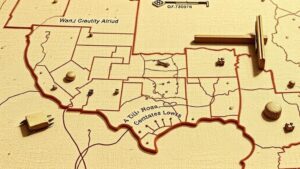Following Watercourses and Springs Shown as Vital Clues in Maps
Following Watercourses and Springs Shown as Vital Clues in Maps
Watercourses and springs are significant features on maps that serve not just as geographic markers but also as indicators of environmental, cultural, and historical contexts. Understanding their representation and implications is crucial for experts in fields such as geography, hydrology, urban planning, and ecology. This article guides readers through the importance of following watercourses and springs in maps, discussing how these features contribute vital clues to both natural and human systems.
The Importance of Watercourses in Mapping
Watercourses, including rivers and streams, are essential elements in landscape mapping. dictate land use, infrastructure planning, and even settlement patterns. The visibility of these features on maps helps to inform decision-making processes across various sectors.
For example, the Nile River has been a central focus for Egyptian civilization, with cities such as Cairo and Luxor developing around its banks. Historical maps showcasing the rivers course illustrate its critical role in agriculture and trade throughout ancient times. Similarly, in contemporary contexts, watercourses enable planners to assess flood risks and allocate resources effectively.
Springs as Indicators of Geology and Ecology
Springs represent natural discharge points of groundwater. When represented on a map, they provide insights into underlying geological formations and land-water interactions. The presence of springs may indicate aquifers and groundwater recharge areas, crucial for assessing water availability and ecosystem health.
- Example of the Appalachian Region: The Great Smoky Mountains National Park hosts numerous springs that serve as both biodiversity hotspots and drinking water sources for surrounding communities.
- Case Study of the Edwards Aquifer: In Texas, the Edwards Aquifer is depicted on maps to show springs that are vital for sustaining local ecosystems, particularly during drought periods.
Environmental and Social Implications of Watercourses
Watercourses have profound implications for both the environment and society. Ecologically, rivers and streams create habitats for various species, maintain biological diversity, and regulate nutrient cycling. In terms of social impacts, access to watercourses often influences community development and recreational opportunities.
Urban planners frequently reference watercourse maps to ensure sustainable development. Areas near water bodies may be prioritized for parks or conservation efforts to maximize ecological benefits while minimizing flood risks. For example, after the implementation of the Green Streets initiative in Portland, Oregon, planners integrated existing waterways into urban infrastructure, enhancing ecological flows while benefiting local communities.
Mapping Techniques and Technologies
Advancements in technology have significantly altered how watercourses and springs are mapped. Geographic Information Systems (GIS) and remote sensing technologies enable detailed and dynamic representations of these features, allowing researchers to analyze changes over time. For example, GIS can integrate hydrological data with urban planning tools, producing comprehensive maps that depict flood zones, aquifer recharge areas, and potential water quality degradation sites.
- Case Study of the Amazon Basin: Satellite imagery and GIS have been utilized to monitor deforestation impacts on watercourses, aiding conservation efforts.
- Hudson River Monitoring: Continuous monitoring of watercourses using remote sensing allows for real-time data collection that can inform local governance decisions regarding flood management.
Cultural and Historical Significance
Historically, watercourses have served as boundaries, trade routes, and sources of life-giving resources. Maps from different eras depict changing perceptions of these waterways, reflecting human adaptation to their geographical contexts. For example, ancient societies often aligned their mythologies and settlement patterns closely with significant rivers like the Ganges in India, emphasizing the spiritual aspect of water.
The study of historical maps provides valuable insights into these aspects. They reveal how navigation, transportation, and water management evolved, influencing various civilizations. Modern maps continue this legacy by incorporating cultural elements, highlighting the significance of watercourses in contemporary life.
Conclusion: Actionable Takeaways
Following watercourses and springs as presented on maps offers a multitude of insights that are crucial across several domains, whether for ecological studies, urban planning, or historical research. To maximize these insights, stakeholders should consider the following actionable tips:
- Use GIS technology to create layered maps that include ecological, hydrological, and social data.
- Engage local communities in water resource management initiatives, utilizing their knowledge of local watercourses.
- Incorporate historical maps into environmental education efforts to highlight the historical relationship between humans and water.
Navigating the interplay between watercourses and socio-environmental systems remains a dynamic challenge, fostering the need for continued research, collaboration, and innovative mapping strategies.



